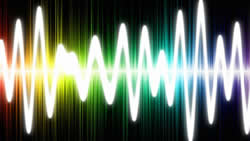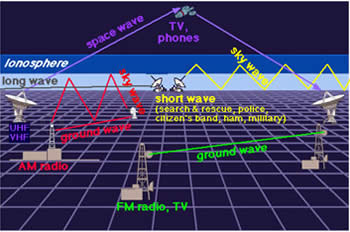Difference between Sound Waves and Radio Waves
Key Difference: Sound waves are commonly related to the travel of sound. Sound is technically defined as a mechanical disturbance traveling through an elastic medium. Sound is a mechanical vibration that passes through a medium such as gas, liquid or solid to become a sound. Radio waves are a type of wave that is part of the electromagnetic radiation and it has the longest wavelength on the spectrum. This means that it has low frequency and low energy. Radio waves can be produced by nature as well as artificially.
 Sound waves and radio waves are two different types of waves that we encounter everyday. Sound waves are responsible for the travel of sound using a medium, while radio waves are a type of electromagnetic waves that are responsible for radio communication, broadcasting, radar and many other navigation systems. These are important in everyday usage as hearing is one of the most important senses that we use.
Sound waves and radio waves are two different types of waves that we encounter everyday. Sound waves are responsible for the travel of sound using a medium, while radio waves are a type of electromagnetic waves that are responsible for radio communication, broadcasting, radar and many other navigation systems. These are important in everyday usage as hearing is one of the most important senses that we use.
Sound waves are commonly related to the travel of sound. Sound is technically defined as a mechanical disturbance traveling through an elastic medium. The medium is not limited to air but can also include wood, metal, stone, glass and water. Sound travels in waves, these are known as sound waves. The most common method of traveling includes the air. Similar to all matter, air is also made up of molecules. These molecules are constantly in motion and great speed. When they are in this speed, molecules tend to bump into each other causing transference of energy. Sound are said to travel in waves because when an object is struck (for example a drum), the drum head moves back and forth and pushes against the air in the same fashion. The push and pull of the air causes the sound to bump against other molecules in the air and transfer this energy, resulting in sound waves.
Sound travels in two types of waves: longitudinal and transverse waves. Longitudinal waves are waves whose direction of vibration is the same as their direction of travel. In layman’s terms the direction of the medium is the same or the opposite direction to the motion of the wave. Transverse wave is a moving wave that consist of oscillations perpendicular to the direction of the energy transfer; for example if a wave is moving in a vertical fashion, the energy transfer is moving in an horizontal fashion.
The properties of sound waves include: Frequency, Wavelength, Wavenumber, Amplitude, Sound pressure, Sound intensity, Speed of sound and Direction. The speed of sound is an important property that determines the speed at which sound travels. The speed of sound differs depending on the medium through which it travels. The greater the elasticity and the lower the density, the faster a sound travels. Because of this sound travels faster in solids compared to liquids and faster in liquids compared to gas.
According to How Stuff Works, “At 32 °F. (0 °C.), the speed of sound in air is 1,087 feet per second (331 m/s); at 68 °F. (20 °C.), it is 1,127 feet per second (343 m/s).” The wavelength of a sound is the distance the disturbance travels in one cycle and is related to the sound’s speed and frequency. High frequency sounds have shorter wavelengths and low frequency sounds having longer wavelengths.
 Radio waves are a type of wave that is part of the electromagnetic radiation and it has the longest wavelength on the spectrum. This means that it has low frequency and low energy. Radio waves have frequencies between 3 kHz and 300 GHz with wavelengths ranging between 1 mm to 100 km. However, similar to all electromagnetic wave, these also travel at the speed of light. The various different wavelengths are used for many different things.
Radio waves are a type of wave that is part of the electromagnetic radiation and it has the longest wavelength on the spectrum. This means that it has low frequency and low energy. Radio waves have frequencies between 3 kHz and 300 GHz with wavelengths ranging between 1 mm to 100 km. However, similar to all electromagnetic wave, these also travel at the speed of light. The various different wavelengths are used for many different things.
Radio waves can be produced by nature as well as artificially. Naturally occurring radio waves are made by lightening or astronomical objects. Artificially created radio waves are used in TV, radios, broadcasting and navigational systems. This is why during heavy lightening and thunderstorms, radios and TVs can become unclear or stop working. The radio waves from the lightening interferes with the artificial ones. The most important object radio waves are used for communication satellites and mobile phones, which means without radio waves the expensive iPhone is basically just an expensive paper weight. In addition to communications, radio waves have also been used in medicine for surgeries, treating sleep apnea and MRIs.
Radio waves were first postulated by James Clerk Maxwell. Maxwell discovered wavelike properties of light and similarities in electrical and magnetic waves. He then created equations suggesting light waves and radio waves traveling in space, radiated by a charged particle as it undergoes acceleration. These theories were further experimentally proved by Heinrich Hertz; who created radio waves in his laboratory. Radio waves shares the properties of electromagnetic waves including: reflection, refraction, polarization, diffraction, absorption, speed, frequency and wavelength.
The major difference between sound waves and radio waves is similar to the difference between sound waves and electromagnetic waves. While sound waves require a medium to travel, radio waves do not. Sound waves and radio waves travel in different frequencies that are used for different purposes. Radio waves are used for various purposes, while sound waves are used for transmitting sound.
Image Courtesy: mashable.com, windows2universe.org









Comments
Very useful answers
mamah obinna
Fri, 06/20/2014 - 05:04
help
alaina
Thu, 01/23/2014 - 21:21
Add new comment